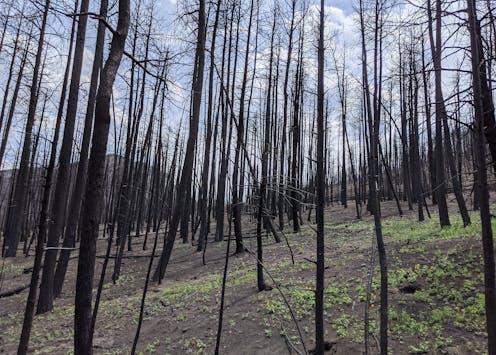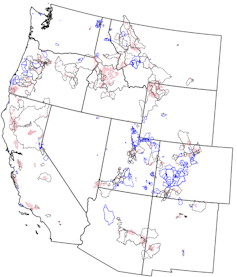Source: The Conversation – France (in French) – By Patrick de Wever, Professeur, géologie, micropaléontologie, Muséum national d’histoire naturelle (MNHN)
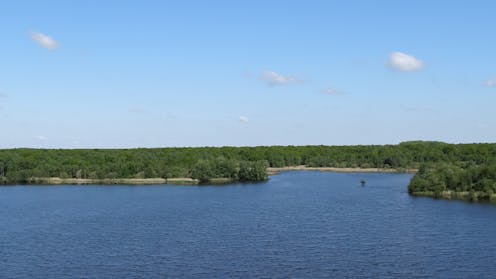
Au-delà du sport, le Tour de France donne aussi l’occasion de (re)découvrir nos paysages et parfois leurs bizarreries géologiques. Le XXIe siècle est marqué par un regain de sensibilité à la nature, qui a poussé à la protection de certains sites, sélectionnés parmi de nombreuses possibilités. Mais paradoxalement, certaines aires sont protégées alors qu’elles semblent polluées… par un phénomène naturel ?
Le naturaliste respecte tout ce qui vient de la nature. De cette dernière il exclut généralement l’humain et ses œuvres, tant elles portent atteinte à un équilibre sain. En témoignent les nombreuses traces laissées par le passé industriel de notre pays : certaines sont visibles (bâtiments en ruines…), quand d’autres, plus insidieuses, sont chimiques (sols pollués).
Et pourtant, en France, certaines pollutions et désordres industriels sont aujourd’hui classés… comme des réserves naturelles.
La troisième étape du Tour de France 2025, le 7 juillet dernier, a permis de l’illustrer avec deux exemples : les pelouses métallicoles de Mortagne-du-Nord et la « Mare à Goriaux », deux réserves biologiques du Parc Naturel régional Scarpe-Escaut traversées par la route dans la forêt de Saint-Amand, à une dizaine de kilomètres de son départ. Nous évoquerons aussi un troisième cas dans le Massif central, que les cyclistes parcourront lors de la 10e étape, le lundi 14 juillet 2025.
Pelouses métallicoles et plantes hyperaccumulatrices
Éliminer les cicatrices que l’humain a laissées en maltraitant la Terre n’est pas chose aisée et les approches sont aussi variées que les causes sont différentes. Les blessures visuelles se résorbent quand les moyens financiers sont mobilisés. La pollution chimique en revanche requiert, outre des subsides, un bien non achetable : du temps.
Magie de la nature, certaines plantes dites hyperaccumulatrices ont la propriété de prospérer sur des sols qui empoisonneraient la plupart des autres. Elles ne sont pas rares : on en connaît près de 400 espèces. La plupart bioaccumulent un ou deux métaux, mais certaines prélèvent un plus large éventail, en pourcentage variable selon le polluant.
Du lundi au vendredi + le dimanche, recevez gratuitement les analyses et décryptages de nos experts pour un autre regard sur l’actualité. Abonnez-vous dès aujourd’hui !
Ces capacités d’extraction par des plantes qui absorbent et concentrent dans leurs parties récoltables (feuilles, tiges) les polluants contenus dans le sol sont utilisées pour la dépollution : on parle de phytoremédiation. Le plus souvent, les végétaux sont récoltés et incinérés : les cendres sont stockées ou valorisées pour récupérer les métaux accumulés.
Mortagne du Nord, commune qui appartient au Parc naturel régional Scarpe-Escaut, en offre un exemple édifiant. Une usine y traitait du zinc, du cadmium, du plomb et quelques terres rares.

Patrick De Wever, Fourni par l’auteur
Désormais, en lieu et place de l’amoncellement de déchets qui y étaient entreposés, prospèrent de jolis prés. Des pelouses dites « métalicolles » ou « calaminaires » qui entourent un collège en pleine nature.
Une réserve biologique fruit d’un effondrement minier
Le nord de la France est connu pour son absence de relief, comme la plaine de Flandre, vers Dunkerque, ou la région marécageuse de Saint-Amand-les-Eaux. Cette horizontalité est démentie par une dépression, notamment visible sur certaines routes.
Ainsi, à proximité de la terrible « trouée de Wallers-Arenberg », passage célèbre du Paris-Roubaix, une route montre une dépression très nette qui semble évoquer le passage d’une rivière. Or il n’y a pas de rivière. Quelle peut en être l’explication ?
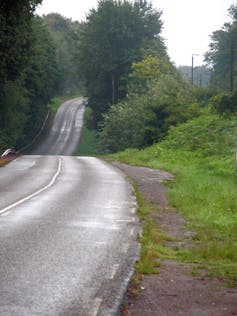
Patrick de Wever, Fourni par l’auteur
La dépression de la route ci-dessus permet de quantifier l’effondrement topographique. On notera, sur la partie droite de la photo, que la ligne de chemin de fer est restée horizontale car un remblai régulier était effectué. C’est d’ailleurs ce remblai, pris annuellement en charge par les houillères, qui a permis de les rendre responsables de cet effondrement. La gauche de la route, derrière les arbres, est bordée par le terril qui délimite la Mare à Goriaux (gorets en picard), une zone naturelle protégée installée sur un terril plat.
Les bois de la gauche de la route sont ceux de la « Mare à Goriaux », une réserve naturelle créée suite à un affaissement minier en 1916. En effet, il existait là un ancien terril horizontal – avant de prendre leur forme conique avec la mécanisation des apports, les terrils étaient horizontaux car alimentés par des wagonnets poussés par des hommes ou tirés par des chevaux. L’affaissement a formé trois mares, qui ont fini par se réunir en 1930 en un seul plan d’eau, la Mare à Goriaux.
La colonisation des lieux par la flore et la faune, riche et diversifiée, a conduit à décréter ce lieu réserve biologique domaniale de Raismes-St Amand-Wallers en 1982.
Une source de pétrole au cœur de l’Auvergne
La nature rejette du pétrole depuis toujours : on en connaît dans les Caraïbes tant au fond de la mer, où il suinte et est constamment digéré par des bactéries spécialisées, qu’à terre. Il était déjà utilisé par les Amérindiens Olmèques 12 siècles avant notre ère, afin d’imperméabiliser les toitures, étanchéifier les navires, les canalisations, les récipients ou décorer des masques. Dans l’Antiquité Classique, il a servi à étanchéifier les jardins suspendus de Babylone, à enduire l’arche de Noé ou à conserver les momies.
Si le bitume affleurait en surface dans toutes les régions aujourd’hui connues comme étant pétrolifères, de l’Arabie saoudite à l’Iran (alors la Perse) en passant par l’Irak (alors la Mésopotamie), en France, le pétrole est plus rare. Il existe néanmoins un endroit où il coule en surface.
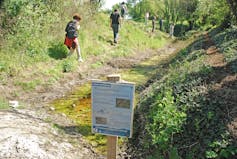
Patrick de Wever, Fourni par l’auteur
À l’est de Clermont-Ferrand, que traversera le peloton lors de la 10e étape, est visible entre l’autoroute et l’aéroport la « Source de la Poix », un lieu géré par le Conservatoire des espaces naturels. Le bitume qui s’y écoule librement est associé à de l’eau salée, du méthane et des traces d’hydrogène sulfuré, dont l’odeur parfois forte peut évoquer celle d’œufs pourris. Le mélange, qui circule sur une quinzaine de mètres avec un débit extrêmement faible (de l’ordre d’un hectolitre/an), surgit par des fractures dans la roche volcanique, ce qui explique qu’il n’est plus exploité. Dans le passé, il fut utilisé pour calfater (c’est-à-dire, étanchéifier) les embarcations de l’Allier.
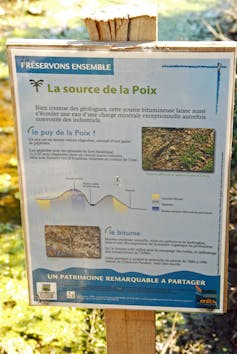
Patrick de Wever, Fourni par l’auteur
Cet hydrocarbure vient des sédiments de Limagne qui se sont déposés dans un grand lac peu profond qui permettait une vie abondante, il y a une trentaine de millions d’années (Oligocène). Celle-ci a évolué avec le temps pour devenir le bitume que l’on trouve aujourd’hui – il ne s’agit pas vraiment de pétrole car il a subi une légère oxydation. N’ayant pas été piégé par une couche ou une structure imperméable, le liquide remonte lentement en surface.
Les suintements de bitumes sont nombreux en Limagne : outre au Puy de la Poix, on en connaît au Puy de Crouël, à la carrière de Gandaillat et à Dallet, à quelques kilomètres, où une mine a été exploitée jusqu’en 1984.
Cette source de bitume a été plus ou moins aménagée au cours des siècles, mais depuis, le site est presque tombé dans l’oubli. Il présente pourtant un joli potentiel pédagogique, d’un point de vue géologique, biologique, environnemental et sociétal.
À lire aussi :
La filière pétrolière française que tout le monde avait oubliée
![]()
Patrick de Wever ne travaille pas, ne conseille pas, ne possède pas de parts, ne reçoit pas de fonds d’une organisation qui pourrait tirer profit de cet article, et n’a déclaré aucune autre affiliation que son organisme de recherche.
– ref. Tour de France 2025 : quand des réserves naturelles émergent sur des sites pollués – https://theconversation.com/tour-de-france-2025-quand-des-reserves-naturelles-emergent-sur-des-sites-pollues-258130

